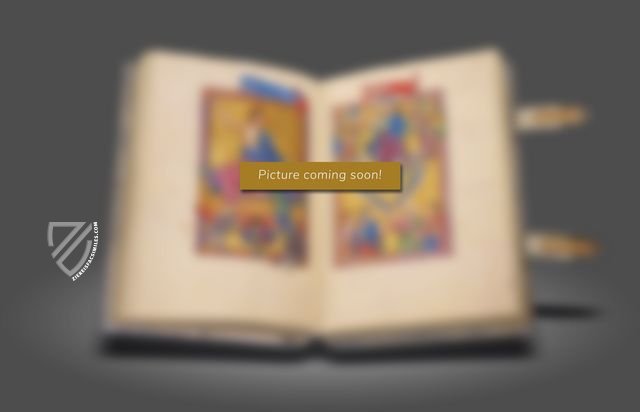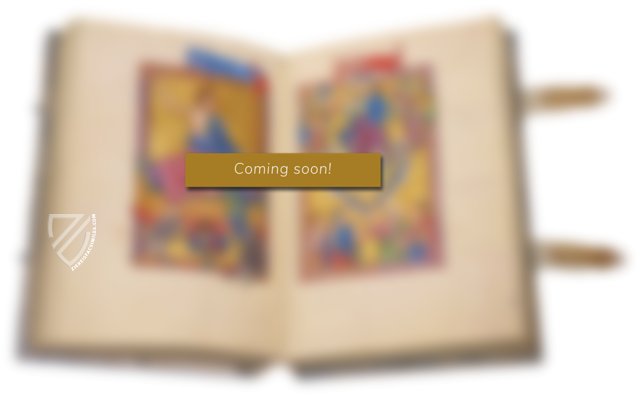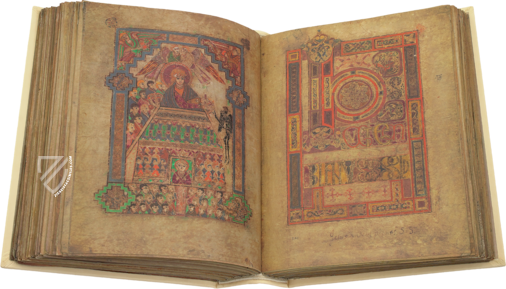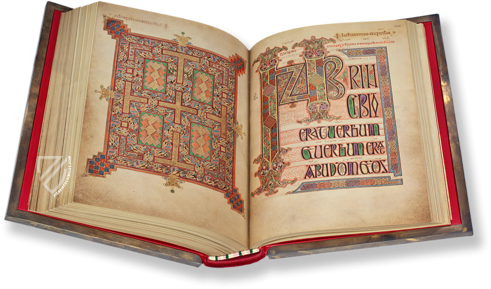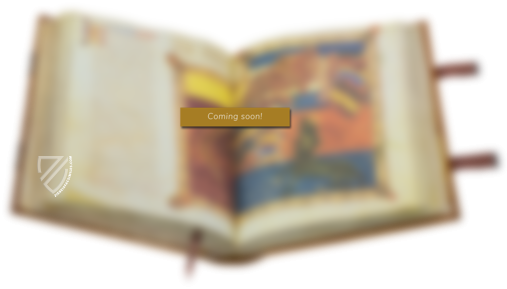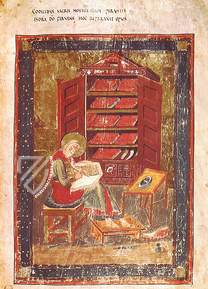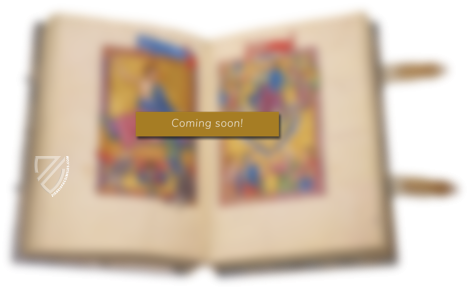Stockholm Codex Aureus
(under 1,000€)
The Stockholm Codex Aureus is the most spectacular manuscript to have been produced in the south of England during the Anglo-Saxon period. Created in the mid-8th century, most likely in Canterbury, the masterpiece combines the native Insular style with models from Late Antique art that were being produced in Italian and Byzantine manuscripts. The folios of the manuscript were alternately dyed purple, a further indication of how much was invested into the production of this precious codex. Two Evangelist portraits, six canon tables, and seven decorative initials adorn the text which is written in gold, silver, and white ink on the purple-dyed pages. The manuscript was originally housed in a luxurious golden cover, probably adorned with precious gems, but this was separated from the rest of the binding when it was looted by Vikings in the 9th century. After being bought back at ransom, the manuscript returned to Canterbury before making its way to Spain and finally Sweden.
Stockholm Codex Aureus
The region of Southumbria produced numerous splendid manuscripts during the Anglo-Saxon period, but the Stockholm Codex Aureus is undoubtedly the finest. Also called the Codex Aureus of Canterbury as a nod to its likely place of origin, it was created in the mid-8th century and has been richly illuminated in a combination of Insular, Italian, and Byzantine styles by artists using gold, silver, purple dye, and the finest pigments available during the period. Purple dye, a color previous reserved for commissions by the Roman emperors or their families, is an indicator of the manuscript’s illustrious origins as a commission from a high-ranking member of Anglo-Saxon society, perhaps even a king. The manuscript’s beauty has brought attention to it over the years from raiders and collectors alike and it continues to be studied as one of the finest specimens of Anglo-Saxon illumination.
A Gorgeous Artistic Program
This large tome consists of a Gospel book with half of the folios dyed purple – thus the purple-dyed pages feature gold, silver, and white ink while the alternating undyed pages are written in black and red. The richness of the materials indicates that the manuscript could have originated as a royal commission, perhaps as a gift. Two of the four full-page Evangelist portraits survive along with six elegant canon tables and seven large decorative initials. The figures in the miniatures and the temples in which we find them are distinctly Late Antique in character and are modeled on specimens from Italian and Byzantine works of art. At the same time, the script and the Chi Ro initial in particular originate from the Insular style, which is especially evident in the intricate interlace patterns and animals that have also been incorporated into the canon tables and the architecture that frames the Evangelist portrait of Saint John. Text pages are colored to create carmina figurata poems formatted to form e.g. crosses and checkerboard patterns. An inscription indicates that the manuscript was made by four monks: Ceolhard, Niclas, Ealhhun, and a goldsmith named Wulfhelm. The Anglo-Saxons are famous for their jewelry and the now-lost luxury binding must have been a spectacular work of gold and precious gems.
A Well-Travelled Masterpiece
This coveted English manuscript has endured a tumultuous history over the last 1,200 years that has taken it from the shores of Britain to the Iberian Peninsula and Scandinavia. According to an inscription in Old English found above and below the text of the Gospel of Matthew, the manuscript was stolen by Vikings during a 9th century raid in Kent, stripped of its luxurious binding, and ransomed. The inscription states that the ransom was paid in gold by Ealdorman Aelfred and his wife Wærburh in order to save it from the heathens and that they were subsequently donated to Christ Church in Canterbury. It likely remained in Canterbury until the 16th century, when it came to Spain under mysterious circumstances, perhaps smuggled out by monks fleeing the dissolution of the monasteries during the English Reformation. The manuscript was purchased in 1690 from the famous library of Gaspar de Haro, seventh Marqués del Carpio (1629‒87) by the Swedish Swedish envoy and distinguished linguist and philologist Johan Gabriel Sparwenfeld (1655‒1727). In 1705, Sparwenfeld donated the manuscript to the Royal Library, and it remains in the National Library of Sweden today.
Codicology
- Alternative Titles
- Codex Aureus in Stockholm
Codex Aureus of Canterbury
Codex Aureus Holmiensis
Canterbury Codex Aureus - Size / Format
- 386 pages / 40.0 × 32.0 cm
- Origin
- United Kingdom
- Date
- Ca. 750
- Epochs
- Style
- Genre
- Language
- Script
- Insular Uncial
- Illustrations
- 2 full-page portraits of the evangelists; 1 page with Christ's monogram (Chi-Rho); 8 decorated canon tables; figure poems (carmina figurata) of gold, silver and white letters on purple background throughout
- Content
- The four Gospels according to the Vulgate as well as preface and canon tables
- Previous Owners
- Ælfred and Wærburh
Catalina de Haro
Johan Gabriel Sparwenfeldt
#1 The Codex Aureus
Language: English
(under 1,000€)
- Treatises / Secular Books
- Apocalypses / Beatus
- Astronomy / Astrology
- Bestiaries
- Bibles / Gospels
- Chronicles / History / Law
- Geography / Maps
- Saints' Lives
- Islam / Oriental
- Judaism / Hebrew
- Single Leaf Collections
- Leonardo da Vinci
- Literature / Poetry
- Liturgical Manuscripts
- Medicine / Botany / Alchemy
- Music
- Mythology / Prophecies
- Psalters
- Other Religious Books
- Games / Hunting
- Private Devotion Books
- Other Genres
- Afghanistan
- Armenia
- Austria
- Belgium
- Belize
- Bosnia and Herzegovina
- China
- Colombia
- Costa Rica
- Croatia
- Cyprus
- Czech Republic
- Denmark
- Egypt
- El Salvador
- Ethiopia
- France
- Germany
- Greece
- Guatemala
- Honduras
- Hungary
- India
- Iran
- Iraq
- Israel
- Italy
- Japan
- Jordan
- Kazakhstan
- Kyrgyzstan
- Lebanon
- Liechtenstein
- Luxembourg
- Mexico
- Morocco
- Netherlands
- Palestine
- Panama
- Peru
- Poland
- Portugal
- Romania
- Russia
- Serbia
- Spain
- Sri Lanka
- Sweden
- Switzerland
- Syria
- Tajikistan
- Turkey
- Turkmenistan
- Ukraine
- United Kingdom
- United States
- Uzbekistan
- Vatican City
- A. Oosthoek, van Holkema & Warendorf
- Aboca Museum
- Ajuntament de Valencia
- Akademie Verlag
- Akademische Druck- u. Verlagsanstalt (ADEVA)
- Aldo Ausilio Editore - Bottega d’Erasmo
- Alecto Historical Editions
- Alkuin Verlag
- Almqvist & Wiksell
- Amilcare Pizzi
- Andreas & Andreas Verlagsbuchhandlung
- Archa 90
- Archiv Verlag
- Archivi Edizioni
- Arnold Verlag
- ARS
- Ars Magna
- ArtCodex
- AyN Ediciones
- Azimuth Editions
- Badenia Verlag
- Bärenreiter-Verlag
- Belser Verlag
- Belser Verlag / WK Wertkontor
- Benziger Verlag
- Bernardinum Wydawnictwo
- BiblioGemma
- Biblioteca Apostolica Vaticana (Vaticanstadt, Vaticanstadt)
- Bibliotheca Palatina Faksimile Verlag
- Bibliotheca Rara
- Boydell & Brewer
- Bramante Edizioni
- Bredius Genootschap
- Brepols Publishers
- British Library
- C. Weckesser
- Caixa Catalunya
- Canesi
- CAPSA, Ars Scriptoria
- Caratzas Brothers, Publishers
- Carus Verlag
- Casamassima Libri
- Centrum Cartographie Verlag GmbH
- Chavane Verlag
- Christian Brandstätter Verlag
- Circulo Cientifico
- Club Bibliófilo Versol
- Club du Livre
- CM Editores
- Collegium Graphicum
- Collezione Apocrifa Da Vinci
- Comissão Nacional para as Comemorações dos Descobrimentos Portugueses
- Coron Verlag
- Corvina
- CTHS
- D. S. Brewer
- Damon
- De Agostini/UTET
- De Nederlandsche Boekhandel
- De Schutter
- Deuschle & Stemmle
- Deutscher Verlag für Kunstwissenschaft
- DIAMM
- Droz
- E. Schreiber Graphische Kunstanstalten
- Ediciones Boreal
- Ediciones Grial
- Ediclube
- Edições Inapa
- Edilan
- Editalia
- Edition Deuschle
- Edition Georg Popp
- Edition Leipzig
- Edition Libri Illustri
- Editiones Reales Sitios S. L.
- Éditions de l'Oiseau Lyre
- Editions Medicina Rara
- Editorial Casariego
- Editorial Mintzoa
- Editrice Antenore
- Editrice Velar
- Edizioni Edison
- Egeria, S.L.
- Eikon Editores
- Electa
- Emery Walker Limited
- Enciclopèdia Catalana
- Eos-Verlag
- Ephesus Publishing
- Ernst Battenberg
- Eugrammia Press
- Extraordinary Editions
- Fackelverlag
- Facsimila Art & Edition
- Facsimile Editions Ltd.
- Facsimilia Art & Edition Ebert KG
- Faksimile Verlag
- Feuermann Verlag
- Folger Shakespeare Library
- Franco Cosimo Panini Editore
- Friedrich Wittig Verlag
- Fundación Hullera Vasco-Leonesa
- G. Braziller
- Gabriele Mazzotta Editore
- Gebr. Mann Verlag
- Gesellschaft für graphische Industrie
- Getty Research Institute
- Giovanni Domenico de Rossi
- Giunti Editore
- Graffiti
- Grafica European Center of Fine Arts
- Guido Pressler
- Guillermo Blazquez
- Gustav Kiepenheuer
- H. N. Abrams
- Harrassowitz
- Harvard University Press
- Helikon
- Hendrickson Publishers
- Henning Oppermann
- Herder Verlag
- Hes & De Graaf Publishers
- Hoepli
- Holbein-Verlag
- Houghton Library
- Hugo Schmidt Verlag
- Idion Verlag
- Il Bulino, edizioni d'arte
- ILte
- Imago
- Insel Verlag
- Insel-Verlag Anton Kippenberger
- Instituto de Estudios Altoaragoneses
- Instituto Nacional de Antropología e Historia
- Introligatornia Budnik Jerzy
- Istituto dell'Enciclopedia Italiana - Treccani
- Istituto Ellenico di Studi Bizantini e Postbizantini
- Istituto Geografico De Agostini
- Istituto Poligrafico e Zecca dello Stato
- Italarte Art Establishments
- Jan Thorbecke Verlag
- Johnson Reprint Corporation
- Josef Stocker
- Josef Stocker-Schmid
- Jugoslavija
- Karl W. Hiersemann
- Kasper Straube
- Kaydeda Ediciones
- Kindler Verlag / Coron Verlag
- Kodansha International Ltd.
- Konrad Kölbl Verlag
- Kurt Wolff Verlag
- La Liberia dello Stato
- La Linea Editrice
- La Meta Editore
- Lambert Schneider
- Landeskreditbank Baden-Württemberg
- Leo S. Olschki
- Les Incunables
- Liber Artis
- Library of Congress
- Libreria Musicale Italiana
- Lichtdruck
- Lito Immagine Editore
- Lumen Artis
- Lund Humphries
- M. Moleiro Editor
- Maison des Sciences de l'homme et de la société de Poitiers
- Manuscriptum
- Martinus Nijhoff
- Maruzen-Yushodo Co. Ltd.
- MASA
- Massada Publishers
- McGraw-Hill
- Metropolitan Museum of Art
- Militos
- Millennium Liber
- Müller & Schindler
- Nahar - Stavit
- Nahar and Steimatzky
- National Library of Wales
- Neri Pozza
- Nova Charta
- Oceanum Verlag
- Odeon
- Orbis Mediaevalis
- Orbis Pictus
- Österreichische Staatsdruckerei
- Oxford University Press
- Pageant Books
- Parzellers Buchverlag
- Patrimonio Ediciones
- Pattloch Verlag
- PIAF
- Pieper Verlag
- Plon-Nourrit et cie
- Poligrafiche Bolis
- Presses Universitaires de Strasbourg
- Prestel Verlag
- Princeton University Press
- Prisma Verlag
- Priuli & Verlucca, editori
- Pro Sport Verlag
- Propyläen Verlag
- Pytheas Books
- Quaternio Verlag Luzern
- Reales Sitios
- Recht-Verlag
- Reichert Verlag
- Reichsdruckerei
- Reprint Verlag
- Riehn & Reusch
- Roberto Vattori Editore
- Rosenkilde and Bagger
- Roxburghe Club
- Salerno Editrice
- Saltellus Press
- Sandoz
- Sarajevo Svjetlost
- Schöck ArtPrint Kft.
- Schulsinger Brothers
- Scolar Press
- Scrinium
- Scripta Maneant
- Scriptorium
- Shazar
- Siloé, arte y bibliofilia
- SISMEL - Edizioni del Galluzzo
- Sociedad Mexicana de Antropología
- Société des Bibliophiles & Iconophiles de Belgique
- Soncin Publishing
- Sorli Ediciones
- Stainer and Bell
- Studer
- Styria Verlag
- Sumptibus Pragopress
- Szegedi Tudomànyegyetem
- Taberna Libraria
- Tarshish Books
- Taschen
- Tempus Libri
- Testimonio Compañía Editorial
- Thames and Hudson
- The Clear Vue Publishing Partnership Limited
- The Facsimile Codex
- The Folio Society
- The Marquess of Normanby
- The Richard III and Yorkist History Trust
- Tip.Le.Co
- TouchArt
- TREC Publishing House
- TRI Publishing Co.
- Trident Editore
- Tuliba Collection
- Typis Regiae Officinae Polygraphicae
- Union Verlag Berlin
- Universidad de Granada
- University of California Press
- University of Chicago Press
- Urs Graf
- Vallecchi
- Van Wijnen
- VCH, Acta Humaniora
- VDI Verlag
- VEB Deutscher Verlag für Musik
- Verlag Anton Pustet / Andreas Verlag
- Verlag Bibliophile Drucke Josef Stocker
- Verlag der Münchner Drucke
- Verlag für Regionalgeschichte
- Verlag Styria
- Vicent Garcia Editores
- W. Turnowski Ltd.
- W. Turnowsky
- Waanders Printers
- Wiener Mechitharisten-Congregation (Wien, Österreich)
- Wissenschaftliche Buchgesellschaft
- Wissenschaftliche Verlagsgesellschaft
- Wydawnictwo Dolnoslaskie
- Xuntanza Editorial
- Zakład Narodowy
- Zollikofer AG

